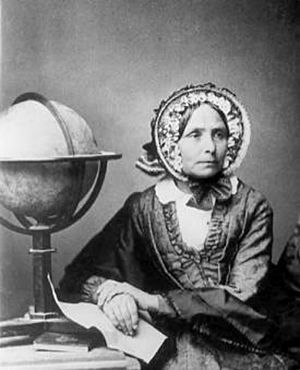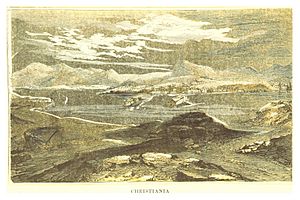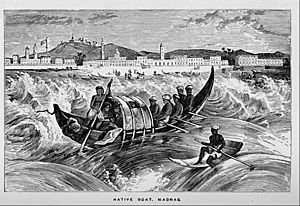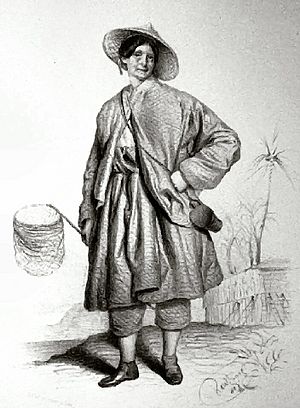Ida Laura Pfeiffer facts for kids
Ida Laura Pfeiffer (born October 14, 1797, in Vienna – died October 27, 1858, in Vienna) was an amazing Austrian explorer and writer. She was one of the first women to travel all over the world by herself!
Ida's travel journals were so popular that they were translated into seven languages. She traveled about 32,000 kilometers (20,000 miles) on land and 240,000 kilometers (150,000 miles) by sea. Her journeys took her through Southeast Asia, the Americas, the Middle East, and Africa. She even went around the world twice between 1846 and 1855.
Ida was a member of important geographical groups in Berlin and Paris. However, the Royal Geographical Society in London did not allow women to join until 1913, so she couldn't be a member there.
Contents
Early life and dreams
Ida Reyer was born in Vienna on October 14, 1797. Her father was a rich textile maker. She had five brothers and a younger sister. As a child, Ida loved wearing boys' clothes and playing sports. Her father encouraged her to learn the same things as her brothers.
Ida wrote that she was "wild as a boy, and bolder and more forward than my elder brothers." When she was only five years old, she took a long trip to Palestine and Egypt. This journey made a big impression on her.
After her father died in 1806, her mother wanted Ida to be more traditional. She made Ida wear dresses and take piano lessons. When Napoleon Bonaparte's soldiers came to Vienna in 1809, some stayed in Ida's home. Ida didn't like this. She even turned her back when the generals rode past during a big parade, showing she was against the foreign soldiers.
Her teacher, Franz Josef Trimmel, told her about famous explorers. Ida especially loved reading Robinson Crusoe and the books by Alexander von Humboldt. She even got to meet Humboldt later in her life!
On May 1, 1820, Ida married Dr. Mark Anton Pfeiffer, a lawyer. He was 24 years older than her. They moved to Lemberg (now Lviv, Ukraine). Dr. Pfeiffer soon lost his job after he found out about corruption in the government. This made it hard for him to find new work. To help her family, Ida moved between Vienna and Lemberg. She gave drawing and music lessons and borrowed money from her brothers.
Ida had two sons in Vienna: Alfred (born 1821) and Oscar (born 1824). Their family's money situation got a little better after her mother died in 1831. With a small inheritance, Ida could continue her sons' education. She stayed in Vienna with her boys in 1833, while Dr. Pfeiffer remained in Lemberg.
Amazing travels
First journeys: Istanbul, Jerusalem, and Iceland (1842–1845)
Once her sons had jobs, Ida Pfeiffer could finally follow her childhood dream of traveling. She wrote in one of her books:
When I was but a little child, I had already a strong desire to see the world. Whenever I met a travelling-carriage, I would stop involuntarily, and gaze after it until it had disappeared; I used even to envy the postilion, for I thought he also must have accomplished the whole long journey.
In 1842, she traveled along the Danube river to Istanbul. From there, she went to Jerusalem, stopping in places like Gallipoli, Smyrna, Rhodes, Cyprus, Beirut, Caesarea, and Jaffa. She then sailed to Egypt, visiting Alexandria, Cairo, and the Red Sea. She returned home through Rome.
Ida wrote about this trip in a book called Reise einer Wienerin in das Heilige Land (A Vienna woman's trip to the Holy Land). She published it without her name at first. The book was a huge success and helped her pay for her next journey.
In 1845, Pfeiffer went to Scandinavia and Iceland. To get ready, she learned English and Danish. She also learned how to collect and keep natural things like plants and how to take early photographs called daguerreotypes. Her adventure started on April 10, 1845. She traveled from Vienna to Copenhagen, then sailed to Hafnarfjörður in Iceland. She rode a horse to Reykjavík and explored the hot spring area of Krýsuvík. She also visited the beautiful Golden Falls and climbed the volcano Mount Hekla. After Iceland, she traveled to Gothenburg, Sweden and then to Norway.
She came back to Vienna on October 4, 1845. The next year, she published her journal: Reise nach dem skandinavischen Norden und der Insel Island (Trip to the Scandinavian North and the island of Iceland). This book was also translated into English.
First trip around the world (1846–1848)
In 1846, Ida Pfeiffer began her first trip around the world! She visited Brazil, Chile, Tahiti, China, India, Persia, Asia Minor, and Greece. She returned to Vienna in 1848. She wrote about this amazing journey in Eine Frauenfahrt um die Welt (A Woman's Journey round the World).
She sailed from Hamburg to Rio de Janeiro, Brazil, arriving on September 16, 1846. She explored the forests of Brazil. Then she sailed to Valparaiso, Chile, and later to the island of Tahiti. On July 9, she arrived in Macao, China.
For the next two months, she visited temples and villages in Hong Kong. She also went hunting in Singapore, explored Colombo and Kandy in Sri Lanka, and learned about traditions in Calcutta, India. She visited the holy city of Benares. From Delhi, she traveled by bullock cart to Bombay, passing through Hyderabad and seeing the Daulatabad Fort and the Ellora Caves.
On April 23, 1848, she left Bombay for Baghdad, which was part of the Ottoman Empire then. She explored old ruins and met important people. She visited the ancient cities of Babylon, Borsippa, and Nineveh. She also visited homes in Tabriz, Iran.
In August 1848, she traveled to Nakhchivan near Armenia, and then joined a group heading to Tbilisi, the capital of Georgia. From there, she crossed the Black Sea into the Russian Empire.
Her book, A Woman's Journey Round the World, was published in 1850. It was translated into many languages, including Dutch, French, and Russian. Many international newspapers and magazines wrote good reviews about it.
Second trip around the world (1851–1855)
To pay for her next big trip, Ida sold some of the specimens she had collected to the Royal Museum of Vienna. She also received money from the government because she was so good at finding rare items from faraway places.
In 1851, she went to Berlin and met many excited people. One of them was her childhood hero, the famous explorer Alexander von Humboldt. His travels had inspired many scientists, including Charles Darwin. Ida also met German mapmaker Carl Ritter. From Hamburg, she sailed to London and met other important scientists.
On May 27, 1851, Pfeiffer left for Cape Town, South Africa. She arrived on August 11 and sent a box of specimens back to the Natural History Museum in Vienna. She wanted to go deeper into Africa, but it was too expensive.
She then traveled across the Indian Ocean to the Malay archipelago. She spent two weeks in Singapore, collecting new types of insects and sea creatures. She spent 18 months in the Sunda Islands, visiting the Dayaks of Borneo and the Bataks in Sumatra. She was one of the first explorers to write about their traditions. She collected many valuable specimens, including fish and plants.
On July 6, 1853, she sailed across the Pacific Ocean to North America. She arrived on the West Coast of the United States during the California Gold Rush. She visited cities like Sacramento and San Jose before heading south to Central America. After stopping in places like New Granada and Peru, she returned to Guayaquil, Ecuador.
On May 31, 1854, she took a boat to New Orleans. She stayed there for three weeks, then toured the Great Lakes Region. In her journal, she wrote about visiting American circuses, theaters, and even a prison. She also met famous people like writer Washington Irving and scientist Louis Agassiz.
Ida returned to Vienna at the end of July 1855. She finished her book, Meine zweite Weltreise (My second trip around the world), which was published in 1856. This book was also translated into many languages and received good reviews.
Final journey: Madagascar (1856–1858)
In May 1857, Pfeiffer set off to explore Madagascar. Her first stop was Cape Town, South Africa. In Madagascar, she accidentally became involved in a plan to replace the queen, Ranavalona I. Because of this, she was forced to leave Madagascar in July 1857.
During her journey from the capital of Antananarivo to the coast, she got very sick, probably with malaria. She never fully recovered. She suffered from fevers on Mauritius and left for London on March 10, 1858. She then traveled to Hamburg but became sick again.
Ida Laura Pfeiffer died in Vienna on October 27, 1858, at her brother's home. A book describing her last trip, Reise nach Madagaskar (Trip to Madagascar), was published in 1861. It also included a biography written by her son Oscar.
Natural history discoveries
During her many travels, Ida Pfeiffer collected many different things. She gathered plants, insects, snails, sea creatures, and minerals. Many of these were sold to museums, including the Museum für Naturkunde in Berlin and the British Museum.
Some of the creatures she collected even had her name given to them! These include:
- A type of Orb-weaver spider (Poltys idea)
- A stick insect (Lonchodes pfeifferae)
- A freshwater prawn (Palaemon idae)
- Two types of snails (Vaginula idae and Pupina superba)
The Naturhistorisches Museum in Vienna bought 721 specimens from Ida's collection from Madagascar and Mauritius. These included many types of mammals, birds, reptiles, crustaceans, mollusks, spiders, and insects.
How Ida influenced others
Ida Pfeiffer was mentioned by famous writers and scientists.
- Henry David Thoreau mentioned her in his book, Walden. He wrote about how she dressed in more formal clothes as she got closer to home.
- Alfred Russel Wallace, another famous naturalist, often wrote about Pfeiffer in his letters. Wallace even visited many of the same places that Ida had explored, like the Malay Archipelago.
- Charles Darwin mentioned Pfeiffer in his book Descent of Man (1871).
Ida's legacy
In 1892, Ida Pfeiffer's remains were moved to a special place in the Vienna Central Cemetery. She was the first woman to be honored in this way.
In 2000, a street in Munich, Germany, was renamed Ida-Pfeiffer-Straße (Ida Pfeiffer Street) in her honor.
In 2018, the University of Vienna created an "Ida Pfeiffer Professorship" in their Faculty of Earth Sciences, Geography, and Astronomy. This shows how important her work in geography and exploration is still considered today.
Historians who study travel are very interested in Ida Pfeiffer. Many books have been written about her life and adventures, including:
- Hiltgund Jehle's Ida Pfeiffer: Weltreisende im 19. Jahrhundert (1989)
- Gabriele Habinger's collection of her letters
- John van Wyhe's 2019 biography, Wanderlust
|
See also
 In Spanish: Ida Laura Pfeiffer para niños
In Spanish: Ida Laura Pfeiffer para niños






